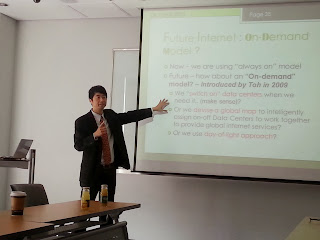When working on terrestrial wireless sensor networks (WSN), we are dealing with electro-magnetic waves to propagate our signals from a sender to a receiver. However, underwater sensor networks are significantly different from their terrestrial counterpart due to the usage of acoustic signals for communication. In underwater environments we are unable to depend on radio signals for communication in long distances since higher attenuation of radio signals when traveling through water. Therefore acoustic signals is the only or most prominent and practical solution so far.
Simulating underwater acoustic sensor networks (UASN) requires special propagation models and other considerations specific to the unique features of acoustic physical medium . Due to this reason, its not possible to simulate UASNs using simulators used for terrestrial WSNs with same configurations. That means we need simulators which specifically support UASNs. Aqua-Sim is such a simulator which is based on NS-2 and therefore I found it easier to use than learning a completely new simulator. Today I installed it and ran a test TCL script to initiate using it for my simulation requirements of UASN. Since its a modified version of standard NS2 simulator, there's nothing new to be done to install it. However since I faced some error during the installation, I decided to write down the steps I followed for future reference.
First I had to download the source files of Aqua-Sim from the following link. At the end of the page pointed by this link, they have provided a download link for 1.0 version of Aqua-Sim. After downloading I extracted the compressed folder to the desktop of my Ubuntu 12.04 system. Entered the following commands in the terminal to install Aqua-Sim on my system.
cd Desktop/Aqua-Sim-1.0/
./install
After running the installation process for a while, suddenly it turned out with an error saying "ld: libotcl.so: hidden symbol `__stack_chk_fail_local' isn't defined". After searching in the web for this error I found the solution mentioned in this blog. According it, I had to edit a configuration file, so I opened the file Aqua-Sim-1.0/otcl-1.12/configure and searched for the line SHLIB_LD="ld -shared" inside it. Then I commented and added a different line as shown below.
#SHLIB_LD="ld -shared"
SHLIB_LD="gcc -shared"
SHLIB_LD="gcc -shared"
Then I ran the command "./install" again and this time it worked. At the end of the installation process, as usual in NS2 installation, it asked for setting some environmental variables in my system. So I opened the "/etc/profile" file and added the following lines at the end of the existing content and saved.
export PATH=$PATH:/home/asanka/Desktop/Aqua-Sim-1.0/bin:/home/asanka/Desktop/Aqua-Sim-1.0/tcl8.4.13/unix:/home/asanka/Desktop/Aqua-Sim-1.0/tk8.4.13/unix
export LD_LIBRARY_PATH=/home/asanka/Desktop/Aqua-Sim-1.0/otcl-1.12:/home/asanka/Desktop/Aqua-Sim-1.0/lib
export TCL_LIBRARY=/home/asanka/Desktop/Aqua-Sim-1.0/tcl8.4.13/library
export LD_LIBRARY_PATH=/home/asanka/Desktop/Aqua-Sim-1.0/otcl-1.12:/home/asanka/Desktop/Aqua-Sim-1.0/lib
export TCL_LIBRARY=/home/asanka/Desktop/Aqua-Sim-1.0/tcl8.4.13/library
Now we are done with installation. Just to make sure that the installation went fine, I ran the validation script as follows. It takes a long time for the validation scripts to complete.
cd Aqua-Sim-1.0/ns-2.30
./validate
After the validation script finished the execution, I ran a sample TCL simulation script as shown below.
cd /ns-2.30/underwatersensor/uw_tcl
ns tmac-example.tcl
ns tmac-example.tcl
This script executed successfully indicating that everything is OK and Aqua-Sim is ready for my future simulations of UASN networks. Cheers!


